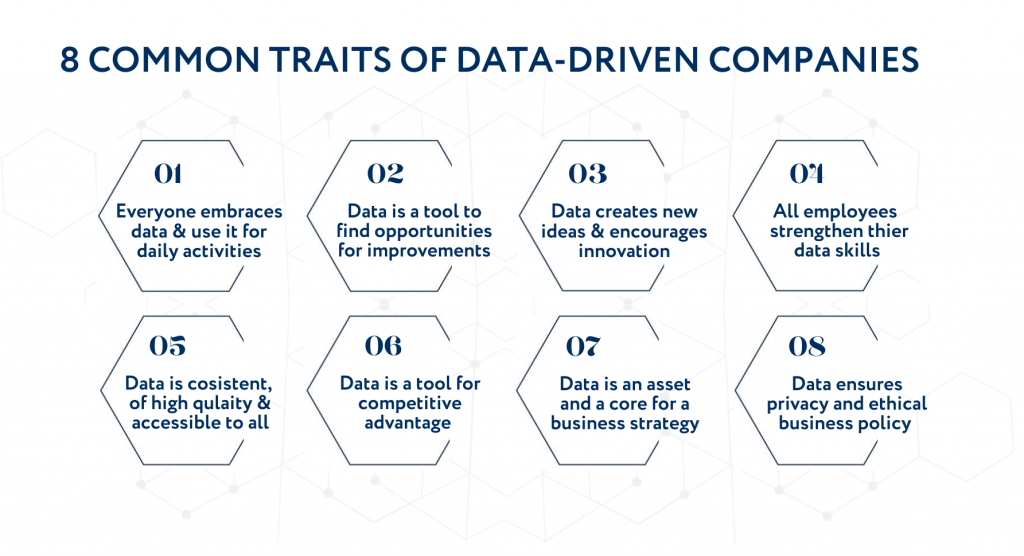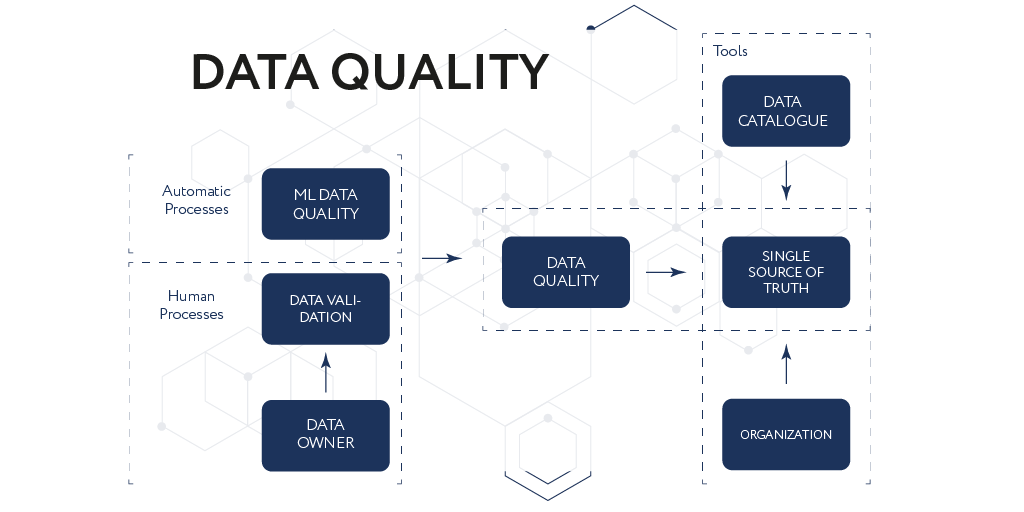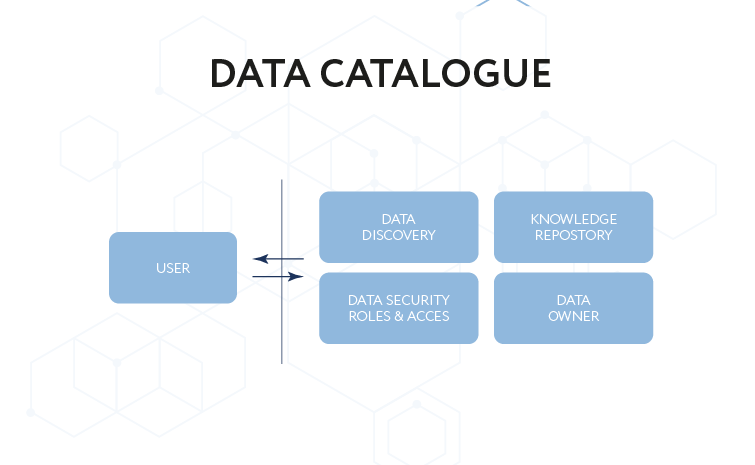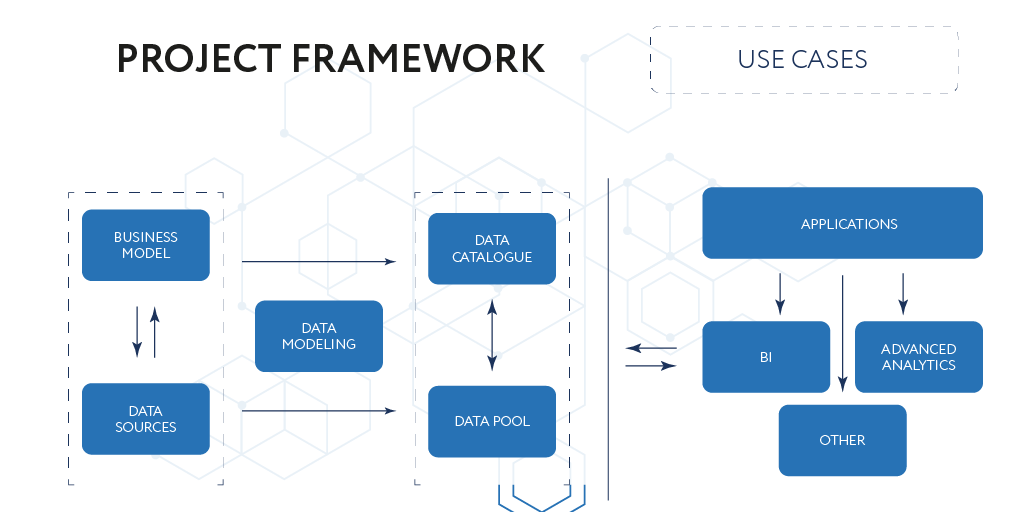Data is growing, and it is expected to reach the level of 175 zettabytes by 2025. These numbers are especially remarkable when we see that in 2019 the volume of generated data was hardly exceeding 45 zettabytes. Yet, for the businesses it is not the quantity that matters, but the ability to use it properly when they want to become a successful data-driven company.
Seeing how disruptive data trends can be for different markets, regardless the industry or sector, there are more and more organizations that feel the necessity to implement Data Strategy and become a data-driven companies. Yet, the technological aspects of data-centred digital transformation may still look like “Terra incognita”. This is an article for those who need clarity at the starting process.
What Does Data-Driven Mean?
What are the TOP 3 BENEFITS of becoming a data-driven business?
According to Forrester report, those companies that have already adopted data-driven culture “are growing at an average of more than 30% annually” keeping the competitors far behind.
That happens because they use a data-driven approach, meaning that the decision making is based on empirical evidence and reliable insights from data, a verified and analysed information. It helps to identify new business opportunities, improve real-time customers’ service, increase sales and refine operations.
Those companies whose managers rely on technology tools and data professionals can truly benefit from the data and uncover its value. But it is not possible to collect, store, analyze and proper protect business data without a data-driven culture in place…
Data-driven culture
A data-driven culture is one that motivates and equips the leaders to use data and advanced analytics tools to get business insights, take informed actions and achieve positive business outcomes. It provides data-driven organizations with a competitive advantage and strategical improvements. According to the joint insights of Garnter, Forbes and Towards Data Science the companies with data-driven culture share the following traits:
- Everyone embraces data, starting at the executive suites
- Data uncovers opportunity to drive improvements
- Data encourages innovation and new ideas are tested
- Employees’ data skills are prioritized and developed
- Data is accessible and consistent, eliminating silos
- Data is a business asset, delivering competitive advantages
- Data is a core business strategy critical to business success
- Ethic and privacy are central tenets of data use

Try out this check list on your company! Do you think it can be done with purely internal resources?
Meanwhile, looking at the features above, it becomes clear that the journey of the transformation into the data-driven company starts with a “psychological” transformation that allows to implement and use efficiently the data strategy best practices. Starting with,
- Digital ecosystems – creating digital ecosystems that allow companies to become data-oriented organizations and to develop advanced analytics projects in an agile way.
- Data Quality – developing a Single Source of Truth with a clear structure of the corporate data and straight-forward access to the information.
- Democratization of Data Analytics and Business Intelligence tools and techniques.
In this article we will focus on these three points showing how they are interrelated and what do they bring in for the company that takes off on their digital transformation journey.
Digital Ecosystems
Why to implement digital ecosystems
A digital ecosystem is a group of interconnected information technology resources that function as a unit. For it to function successfully though, it is needed to make a gradual implementation of different corporate systems, generate massive data of great value and, above all, ensure the interoperability.
You wait to collect a large datalake for your first advanced analytics project and then realize that some data is still missing.
To be able to use this data within digital ecosystem for advanced analytics projects, it should be collected and stored in a standardized way with historical depth and free from errors and inconsistencies.
These processes of integration, cleaning and historicization are expensive and require prioritization. For this reason, organizations must iteratively ask themselves the following two questions:
- Why do we implement digital ecosystems?
- What can we do with the information that we have now?
The first question aims to guide and prioritize the data integration processes, whereas the second one focuses the project work team on how to set the system in motion.
Based on the previous projects experience of our Data Science team, we can state that there are still quite a lot of companies that fall into the wrong prejudice. You think that the company needs to build a massive Data Lake prior to starting any data-bases project. Wrong!
You should not wait until you have a lot of data to start your first advanced analytics project and realize only along the way that there was other data should have been saved as well. Gradual development of the data-driven projects along side with the high-quality Data Lake allows to avoid the insufficient datasets and, additionally, let the timely inspection of the data serve as an inspiration for new possibilities.
But even if the digital ecosystem was built in an unstructured, random way, it is still possible to recover the required data and meet the purpose of the project and its strategic objectives. Data Science specialists call it a data archaeology.
Data Quality
It is time to come to the point and talk about data quality management and why it might be a challenge for a company to pivot around a Data repository. This challenge includes technological and organizational aspects but can be represented in the simple three-elements scheme. This scheme shows how different concepts of data-driven transformation are interrelated to achieve the “Single Source of Truth”:
- Data initiative of the organization
- Access to information
- Quality of the information

All members of the organization should have an easy, quick and convenient access to the information. If not, different teams within the company are encouraged to create their own departmental data pools where they structure the information independently from the transversal data strategy objectives.
Access to the information
Having said that it is fundamental for a data-driven company to provide a straight-forward access to the information, one cannot neglect that it might be a technological and organizational challenge to achieve it.
The intuitive structure of a Data Lake should allow newcomers or those who have not dealt with a specific type of information for some time to find and deal with it easily. The standardization of the Data Storage and Maintenance is usually carried out with the help of Data Catalogues, like the one you can find in the scheme below.

What does a data catalogue technique bring for a data-driven company?
- Data Discovery: the function of “finding data” is achieved via semantic search engines and process mapping. The graphical presentation of the process maps enables the users to inspect the process in question and selects the information he/she wishes to consult. For example, in industrial environments the user can see the production process and select a sensor or actuator from it.
- Knowledge Repository: It is a knowledge management tool that shows how to use the information. For instance, posting examples of how certain information of interest is extracted through SQL or similar methods.
- Data Security and Access: The fact that the information exists does not mean that any member of the company can, or should, access it. To speed up the information access processes, it is advisable to implement the permission system of different levels.
- Data Owner: Finally, if the information is introduced and managed by a particular member of the work team, a so-called Owner, the rest of the team should be able to know who the Data Owner is.
To sum it up, the settings for the direct access to the data require both technological support and organization goodwill to follow a data-driven culture. Especially, when we talk about the maintenance of Knowledge Repository and the part of Data Owner.
Information quality
If the company wants to get a high-quality data, it should not reinvent the wheel and start with the quality of the information. However, as sad as it might sound, no silver bullet can ensure that the collected information is suitable for business analytics, and the level of processing of the obtained information depends on its relevance.
One of the examples from a banking sector shows the case study when two calculation processes were implemented in parallel, and their results were analysed and compared exhaustively. Only when the two implementations provide the same values the information is considered to be correct. In general, advanced analytics techniques can be used to detect outliers, but it is the involvement of the Data Owners and clear specifications of the data semantics and their consequent validations that guarantee its quality. Usually, a team of Data Scientists are involved at this stage to help a company to implement data-driven culture.
Double Input: how to avoid expensive mistake
Last but not least, to make sure that the data generated during the business activity is of high quality and can be used at the point of data-driven decision making, the data strategy operators should avoid double inputs.
They are most frequent in the commercial areas with various communication channels. Due to the multiple sales activities and extensive information that must be registered manually, it is critical to make sure the database is accurate and complete even though it is a time-consuming and thorough task.
Democratization of Data Analytics
Data as a function vs Data as the function
Once unique and quality sources have been obtained, organizations must reflect on the level of democratization of the data, in other words how the data will be used and shared. There are two prototype strategies, and each company, depending on their on their idiosyncrasies, should evaluate which of the two would suit the best its current and future needs.
To create added value starts with identifying the degree of your data autonomy
- Data as a function: Applicable for Centres of Excellence. When executing advanced analytics, “Data as a function” strategy would be the best choice for maximizing the efficiency of scarce resources. This approach gives a full access to the data to all members of the company.
- Data at the function: Over time, certain areas develop a higher level of expertise in data access and data analysis. Given this unique knowledge the team might wish to acquire a certain degree of autonomy in this matter.
A proper tool and a clear data strategy encourages the employees to collaborate and experiment with available data and algorithms, which create added value for the company at different levels and in various ways. For example, by proposing quality insights, choosing a data-driven decision-making testing new business models or optimizing existing processes.
Implementing Data Democratization
Increasing the degree of autonomy of users requires:
- Technology tools that allow data autonomy.
- Training of the members of work team.
- Transition hybrid projects, that support conventional organizations to turn into successful data-driven companies.
In the previous chapters we took a close look at what are the technology tools, how they function in the data-driven companies and why do the companies that wish to implement data-driven business strategy need specialised technological support from external Data Specialists.
The final stage of implementing data democratization includes transition hybrid projects. These projects allow members of the organization, on one hand, to gradually gain digital autonomy, and, on the other hand, to detect training needs that can be resolved on-site or later in time.
Thanks to proper tools, well-trained team and gradual structured integration process, the company may not only carry out successful advance analytics projects but also improve its digital maturity.
Data Modeler: keeping your digital ecosystem flexible
Finally, it is necessary to recognize that organizations are not static structures, therefore, the process of creating a digital ecosystem oriented towards the creation of data-oriented organizations cannot be conceived as a one-of project.
This is why, the function of the Data Modeler responsible for guaranteeing that the new processes or their adaptations are correctly registered/represented becomes especially relevant.

What are the benefits of becoming a data-driven business?
- Helps to identify the business needs and management strategies
- Boosts efficiency and helps to outperform the competition.
- It improves customer satisfaction and retention.
Conclusion
For any businesses to carry out changes at the operational and managerial levels imply financial risks and uncertainties. To start a major shift of the digital transformation and the process of implementing data-driven business strategy may seem like a daunting challenge, especially if doing it with purely internal resources and in-house expertise. Yet, when we cut this “Data Elephant” into smaller feasible projects: developing digital ecosystems, implementing best practices of data management, and introducing data modelling tools, it gives a steady foundation for company.
In this article, we focused your attention on the general topics that the company should keep in mind if it wants to become a successful data-driven company. In the coming one, we will be talking in more detail about the implementation of the latest technologies of the Data Science. Till then, check out our cases of success developed with the help of Machine Learning.


